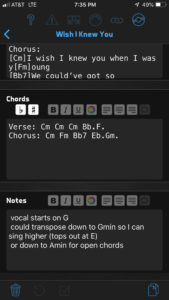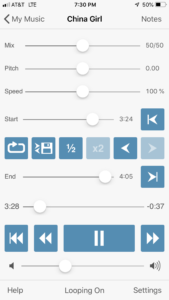The Fearless Voice
I’m not a great singer, but I like to sing. I sing harmonies in many songs with my band The Drop Daddies, but I only really sing the lead vocal when I’m rockin round the campfire. I can sing in tune, and have good relative pitch. But my range is limited, and my head voice is weak, so I’m not the most versatile or confident singer. That said, there are times when I feel great about my voice. What gives?!
There are no great secrets revealed here. Most of this is pretty obvious, but I’ll share my experience in case there are any insights here for you in your singing!
Range and Transposition
My chest voice range is between F2 and E4, which puts me in the Bass vocal range category. In my head voice, I can reach a C5 on a good day, but it sounds weak, and I’ve never found a way to blend my head and chest in a “mix voice”, despite hours of attempts over the years watching vocal instruction on youtube.
When I find a song that matches my chest voice range well, then I’m ok. But those are few and far between. Many male vocalists can reach higher than I can comfortably sing.
Some songs can be transposed down, and still work. My preference is to play guitar while I sing, and it can be a challenge finding a reasonable transposition that allows my voice to fit the song, while still being playable on the guitar. If the vocal works down a full octave, then the song requires no transposition, but often the register of the voice will then collide with the guitar and just sound muddy. Tricky.
Generally, I’ll find the highest note that the singer hits in the song, and then experiment with transpositions that bring that note down into my vocal range, but still work well on the guitar.
Guitar Tuning and Capos
One option is to tune all 6 strings of the guitar down by a semitone or two. This doesn’t always work, and it can make the guitar feel and sound pretty different. The strings become more slack, and the overall tone becomes deeper, which may not be suitable for every song. One example where I like to tune the guitar down is Stone Temple Pilot’s Plush. Scott Weiland belts out an F#4 in the bridge singing “I Feel It”. Tuning the guitar down two semitones brings the word “Feel” to an E4, which I can just reach.
 For some songs played in the open position, it can be helpful to capo up the guitar, which seems a bit counterintuitive if the plan is to sing it lower. But it works.
For some songs played in the open position, it can be helpful to capo up the guitar, which seems a bit counterintuitive if the plan is to sing it lower. But it works.
For example, Gnarls Barkley’s Crazy is an amazing song, but it’s in C minor which is not the most convenient to play on guitar, and CeeLo sings the song crazy high (topping out at a stratospheric C5). I find that transposing it waaaaay down to Dm, and then playing at Capo 5 (so the chord shapes are Am, C, F, E), makes the entire song doable in the range D3-D4 – and it brings CeeLo’s highest “craaaazy” down to D4 which is totally comfortable.
Another option to consider is a baritone guitar, which transposes everything down a 4th. (i.e. playing an open E chord shape sounds as a B chord). But I’ve still never tried playing one- it’s on my todo list! Update May 7, 2020: read about my experience with a baritone guitar.
When the transposition works for both my voice and the guitar, then the song is fair game.
Make It Your Own
When playing covers, I generally like to stay as true to the original as possible, as it helps the audience (or friends round the campfire) connect with the song they know, and to sing along. But sometimes, even after transposing, it’s just not possible to sing the song exactly like the original.
So, it can be helpful to transpose or modify parts of the vocal melody. A-ha’s Take On Me is a classic example of a vocalist singing across an insane range. And it’s a song that everyone knows, and basically no one can sing! Very few vocalists could sing it just like the original- I’m not sure even Morten Harket can! Check out A-ha’s amazing unplugged performance and his very tasteful modification of the chorus to allow him to sing it comfortably. So when I play it, I sing most of it at the original pitch, but transpose parts of it down (especially at the peak of the chorus).
Another example is the dramatic Somebody That I Used To Know by Gotye. I sing this one at original pitch in Dm, with a capo at the 5th fret (chord shapes Am, G, F). But I have to take the chorus down an octave. It’s a bit of a letdown since it’s so climactic in the song, but I try to compensate with dynamics.
Fearlessness
The greatest singers appear to have no fear and sing with abandon.
It can be a real psychological challenge let go of the fear, and silence the nagging voice in your head that’s saying “I’m not good enough” and “my voice is weak” or “I’m afraid I won’t be able to hit the high notes tonight”.
For me, the biggest key to silencing those voices and squashing the fear is to choose the right songs.
Song Choice
It helps to really like the song, and to know it inside out. But just as important is choosing a song that you can reasonably sing. While I love Radiohead, U2, Muse, Paul McCartney, etc- these guys’ vocal ranges are so wide that it nearly impossible to find a song that works for me, even with transposition.
No matter how much I love a song, if I can’t make it work for my voice, then it’s better to be ruthless and take it off the list.
If I know the song works for my range – I’ve worked through it and transposed it as necessary, and know that it’s going to work- then I will feel much more fearless in singing it.
There’s An App For That
I use the Set List Maker and BandHelper iOS apps to work out the songs and write up the lyrics and chords. These apps make it really easy to transpose the chords up/down with the touch of a button, so I can experiment until I find a key that works for both my voice and the guitar.
I also use the Amazing Slow Downer app when transcribing and practicing the song. The app allows you to slow a song down without changing its pitch, so you can figure out the little details. And conversely, it lets you listen to the song transposed up or down without changing the speed- which can sound pretty weird, but is super-useful for practicing with the transposed track.
Some Days Are Better Than Others
On some days, I can inexplicably hit an F4 or even F#4 in my chest voice. I love those days, but they’re exceedingly rare and I haven’t been able to find a correlation with diet, hydration, sleep, stress, etc- but I guess all of those things must contribute. Other days I seem to top out at D4, which sucks!
Warming up definitely helps reach the higher notes, so if I’m going to play a bunch of songs, it’s important to start with the more comfortable songs.
Also, you hear vocal teachers talking about support and breath, and they’re not wrong- making sure you don’t run out of breath is important. Remembering to breath enough and in the right places is a key part of vocal technique, and easy to mess up. That said, breathing right isn’t the silver bullet some teachers claim it to be!
Hallelujah!
I recently tried a song that just lined up all the ingredients for me- Leonard Cohen’s Hallelujah. Yes, it’s one of the most covered songs of all time, so I’m not breaking any new ground here, but it’s a great song!
I’ve never really loved the delivery in Leonard Cohen’s original. But wow, Jeff Buckley’s version is just amazing! And check out this incredible acapella version by the Pentatonix. Of course, I don’t sound anything like any of those!
Transposed into the key of C, the vocal range in this song tops out at E4 – right at the top of my chest voice range. And the song structure builds perfectly to that E4 in a crescendo that allows me to belt out that E4 confidently and fearlessly (assuming I’ve warmed up first!)
All said and done, I love singing it- I feel good about my voice when I’m singing it, and so I sing it well. It’s a keeper!
Save The Keepers, Lose the Weepers
So I’ve started to build a song book in Set List Maker of keepers like Hallelujah- songs that work for me and that I like to sing. For each song, I make a note of the original key, and then any transposition/capo that I use to succeed in the song.
I’ve found myself able to sing- and to really enjoy singing- songs that I never thought possible. Songs like Gnarls Barkley’s Crazy, The Beatle’s Hey Jude, Oasis’ Don’t Look Back In Anger, Bowie’s Starman, and many more.
Another benefit- the more songs you find that you enjoy singing, the more you’ll sing. And unsurprisingly, as with anything, the more you do it, the better you’ll get.
See you round the campfire!


